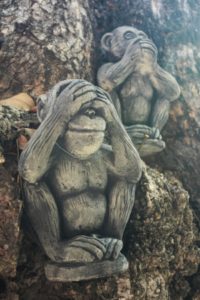Feuding Ideologies, Part 3
“Dying To Be Free,” an article on the opioid addiction crisis, was well written and effectively communicated its message. That message was that abstinence-based treatment “didn’t work well for opioid addicts.” Medication-assisted treatment (MAT), especially with Suboxone, should be the standard of care. Nominated for a Pulitzer, “Dying To Be Free” was said to have influenced “a series of state and federal policy changes” away from abstinence to embrace MAT. But it has a glaring blind spot with regard to MAT, particularly Suboxone.
Pragmatically speaking, abstinent-based treatment and MAT need to learn to work together in order to effectively address the opioid addiction crisis in the U.S. “Dying To Be Free” systematically put these two approaches as being at odds with each other. It suggested we need to choose between the two, and argued that we should choose MAT. In order to support Suboxone MAT, it failed to acknowledge several serious concerns with Suboxone and other MATs. In this sense the persuasive rhetoric of the article had a blind spot.
In what follows, I hope to shine a light on what was missed with regard to Suboxone and other MATs. My intent is to bring to light the potential cons with Suboxone treatment in order to counterbalance the many pros found in “Dying To Be Free.” In order to make a truly informed addiction treatment choice both the strengths and weaknesses, the pros and cons, need to be known and understood.
On September 20, 2017, Scott Gottlieb, the FDA Commissioner released a statement that said combined with counseling and behavioral therapies, MAT (medication-assisted treatment) was one of the main pillars of the federal response to the opioid epidemic. According to the Substance Abuse and Mental Health Services Administration (SAMHSA), it cuts the risk of death from all causes in half among individuals who use MAT to treat their opioid use disorder. But methadone and buprenorphine are themselves opioids and when they are combined with benzodiazepines or other central nervous system (CNS) depressants, there is a risk of serious side effects, such as difficulty breathing, coma and death.
Since the harm caused by untreated opioid addiction can outweigh these risks, the FDA advised against withholding buprenorphine or methadone-based MAT from individuals taking benzodiazepines or other CNS drugs. Nevertheless, the agency is requiring changes to the MAT drug labels to help decrease the risks of combining these drugs. Heath care professionals should educate patients about the risks of combined use, “including overdose and death.” They should taper the benzodiazepine or CNS depressant to discontinuation, if possible. They should verify the diagnosis if a patient was prescribed these drugs for anxiety or insomnia, and consider other treatment options for these conditions.
The new labeling recommends that health care providers develop a treatment plan that closely monitors any concomitant use of these drugs, and carefully taper the use of benzodiazepines, while considering other treatment options to address mental health conditions that the benzodiazepines might have been initially prescribed to address.
The FDA prescribing information for buprenorphine already notes that: “significant respiratory depression and death has occurred in association with buprenorphine,” particularly when it is used intravenously (IV) or in combination benzodiazepines or other CNS depressants, including alcohol. “Many, but not all post-marketing reports regarding coma and death associated with the concomitant use of buprenorphine and benzodiazepines involved misuse by self-injection.” Unintentional exposure of buprenorphine to children, which can cause possibly fatal respiratory depression, was warned against. It also notes the potential for dependence:
Buprenorphine is a partial agonist at the mu-opioid receptor and chronic administration produces physical dependence of the opioid type, characterized by withdrawal signs and symptoms upon abrupt discontinuation or rapid taper. The withdrawal syndrome is typically milder than seen with full agonists and may be delayed in onset. Buprenorphine can be abused in a manner similar to other opioids. This should be considered when prescribing or dispensing buprenorphine in situations when the clinician is concerned about an increased risk of misuse, abuse, or diversion.
Buprenorphine and methadone are both opioids, with the potential for physical dependence. Therefore, they are both diverted from legitimate medical treatment for illicit use. Buprenorphine is a Schedule III controlled substance, while methadone is a Schedule II controlled substance. Buprenorphine is said to have a tolerance ceiling with respiratory depression, meaning it has a lower potential when used alone to cause respiratory depression and death. Given that buprenorphine is a partial agonist, its physical euphoria is less intense than other opioids. But tolerance to many of the effects will develop with prolonged and repeated use.
Methadone was first synthesized by the Nazis, who never brought it into widespread use because of side effects, which included its addictive potential. After WWII, the Americans took control of the factory where methadone, then known as dolophine or polamidon, had been invented. A 1947 study demonstrated its addictive potential, warning if the manufacture and use was not controlled, “addiction to it could become a serious health problem.” See “The Consequences of Ignoring the Past,” for more on methadone.
The addictive potential and the abuse potential for buprenorphine or methadone was not readily discussed in “Dying To Be Free.” Nor were the above-noted concerns of mixing buprenorphine and CNS depressants. The author, Jason Cherkis, did say that neither drug was a miracle cure. “Suboxone blocks both the effects of heroin withdrawal and an addict’s craving and, if used properly, does it without causing intoxication.” But saying both drugs were comparable to “the insulin that a diabetic needs to live” was inaccurate and disingenuous. Chronic, long term use could lead to a lifelong dependency.
There is no getting around this. Chronic, long term use of buprenorphine and methadone produces physical dependence. A too rapid taper or an abrupt discontinuation will produce symptoms of withdrawal. Extended, chronic use over months or years could result in a lifelong reliance on the medication to avoid the discontinuation or withdrawal crisis—and the danger of returning to active illicit opioid use. In the documentary Methadonia, about methadone maintenance in New York City, one individual referred to methadone as “liquid handcuffs.”
Another disturbing blind spot in Dying To Be Free” was its discussion of a 2009 study, “Illicit Use of Buprenorphine/Naloxone Among Injecting and Noninjecting Opioid Users.” Cherkis cited it, stating the majority of addicts surveyed were buying Suboxone on the black market “in an attempt to get sober.” 74% of those surveyed said they were using Suboxone to “ease withdrawal symptoms; 64% said they were using it because they couldn’t afford drug treatment. “Even when purchased on the black market, regardless of the intentions of the user, the medication works as intended — as harm reduction.”
The study abstract contains the information Cherkis noted. But let’s take a closer look at the further results reported in the full article. First recognize the sample size was small: 51 injection opioid drug users (IDUs) and 49 noninjection opioid dug users (non-IDUs). It was also drawn from a limited area, opioid users in Providence, RI. Only 7% reported current employment and 52% reported current homelessness. The 64% who were using diverted Suboxone because they couldn’t afford treatment can be partially attributed to the high unemployment and homelessness figures.
In addition to the results reported by Cherkis was the following data. Among those who had used diverted buprenorphine, 60% reported using it for less than 1 week; 13% for 1 week; and 28% for more than 1 week. Of those using diverted buprenorphine less than 1 week, 32% said they only used it for one day. Fifty-seven percent said they used diverted buprenorphine because they couldn’t obtain heroin; a greater percentage (68%) of IDUs than non-IDUs (41%). Forty-seven percent said they used diverted buprenorphine to ‘get high’; a greater percentage of non-IDUs (69%) than IDUs (32%). Seventy-six percent said it was easy or very easy to obtain Suboxone on the street.
The following quote by Tom Frieden, the former director of the Centers for Disease Control and Prevention (CDC), appeared after the selective reporting on the above study, arguing for the need of more MAT programs: “If buprenorphine is being used and being bought on the street to self-treat addiction, that’s a reflection of a need to have better medically assisted treatment programs out there.”
I don’t really think these patterns of and reasons for diverted buprenorphine use are best described as harm reduction, as Cherkis said. Technically, there are high percentages of individuals saying they used it to reduce withdrawal, and/or self-treat opioid addiction, as well to stay “clean” for some time. But most also said they used buprenorphine because they couldn’t obtain heroin. The reported time of buprenorphine use for the majority of individuals was less than a week; 32% said it was for only one day! In addition, 32% of IDUs and 69% of non-IDUs said they used it to “get high.” It seems it would be more accurate to describe this behavior as attempting a time period of controlled opioid use, rather than a method of harm reduction aimed at curtailing opioid abuse or dependence.
About fourteen months before “Dying To Be Free” was published, “Addiction Treatment With A Dark Side” appeared in The New York Times. It too looked at Suboxone treatment, but presented a different, more nuanced side to Suboxone treatment. Cherkis selected out one aspect of the article, that it “linked hundreds of deaths in the U.S. to buprenorphine and Suboxone.” He focused in on the phrase used to say buprenorphine was a “primary suspect” as a cause of death in CDC data analyzed by the NYT. He then noted caution should be used before attributing a “primary suspect” drug as a cause of death, but neglected to show that is exactly what the NYT article did do.
The NYT article said the 420 deaths with buprenorphine as a “primary suspect” paled in comparison to those reported to the FDA from methadone for the same time period. It also said “The F.D.A. information, which is spare, does show that more than half of the American buprenorphine deaths involved other substances and that only two of 224 cases specifying ‘route of administration’ indicated injection — the primary concern of regulators.” Fifty deaths were noted as suicides, 69 as unintentional overdoses from drug abuse, and 30 were fetal or infant deaths after exposure in the womb.
The NYT claimed some experts believe buprenorphine is not being monitored systematically enough to gauge the full scope of its misuse. The CDC does not track buprenorphine deaths. Most medical examiners, emergency rooms, prisons, jail and drug courts don’t routinely test for it. The director of the Center for Substance Abuse Research at the University of Maryland said: “I’ve been studying the emergence of potential drug problems in this country for over 30 years. . . . This is the first drug that nobody seems to want to know about as a potential problem.”
Then “Addiction Treatment With A Dark Side” had a section noting some of the aggressive actions taken by Reckitt Benckiser, the company that brought Suboxone to market, “to protect its lucrative franchise.” I’ve noted these and similar actions by Reckitt Benckiser in previous articles: “A Double-Edged Drug,” “The Seduction of Opioid Substitution” and “The Opioid Buzzard.” The Times article documented the association between Reckitt Benckiser and the federal government in bringing Suboxone to market, and in providing a place for lucrative employment when government officials left public service for employment in the private sector.
At one point in “Dying To Be Free,” Cherkis said the “squeeze of regulation” was responsible for opportunistic forces, such as “cash only Suboxone clinics and shady doctors,” as well as the “vibrant black market for illicit buprenorphine. Read the section, “Troubled Histories” in the NYT article and the follow up NYT article, “At Clinics, Tumultuous Lives and Turbulent Care” to get a clearer, more accurate picture of the problems with some of the existing Suboxone treatment centers and providers.
You also find a lengthy section describing the benefits of Suboxone treatment. Cherkis did say in “Dying to Be Free” that the NYT article did not question the efficacy of Suboxone when it was used properly. But why didn’t he discuss or cite some of the concerns? I think it was because “Dying To Be Free” was intended to be a persuasive piece of rhetoric to promote the widespread use of buprenorphine in MAT.
Undoubtedly, “Dying To Be Free” has had a significant influence on opioid treatment. But it seems that it did not present a well-rounded picture of both the problems and the benefits with MAT, specifically Suboxone. It seems to have a biomedical bias with regard to conceiving and treating opioid addiction. In Part 1 of “Feuding Ideologies,” I indicated how its rhetoric was a straw man attack on abstinent-based treatment while it extolled MAT. In Part 2, I showed how it misrepresented the recovery philosophy of Alcoholics Anonymous. Here in Part 3, I looked at how its biomedical bias seemed to dismiss or ignore many of the problems with Suboxone as a MAT for opioid addiction.



